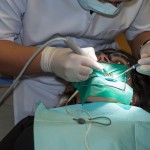
Management of post-endodontic pain is important for both clinicians and patients. A number of factors are considered to influence post-endodontic pain with number of visits, type of irrigation and/or intra-canal medication, instrument technique and root filling technique all considered as potential factors. Several irrigation solutions have been used, the commonest of these being sodium hypochlorite (NaOCL) because of its antimicrobial activity, antibiofilm activity and organic tissue dissolution potency. The concentration of NaOCL used varies in the range 0.5 – 0.8% with a tendency towards higher concentrations however the number of studies of the effect of different concentrations is limited.
The aim of this trial is to compare the effect of two sodium hypochlorite concentrations on post-operative pain and rescue medication use in patients undergoing root canal treatment over two visits.
Methods
Patients aged 25 to 45 years with a nonvital mandibular molar requiring canal treatment were eligible. Patients who had acute Perry apical periodontitis abscess or badly decayed teeth required re-treatment or had severe curved roots were pregnant or lactating or had taken analgesics in the previous 12 hours were excluded. Patients with block randomised using computer generated sequence patients and operators were blind to group assignment. Root canal treatment was completed under rubber dam using a standardised approach with the exception of the irrigation solution used this was either 1.3% or 5.2% NaOCL.
Patients were given a diary to record pain immediately after instrumentation three 24:48 hours and seven days after the first visit and immediately after the root filling was placed. Each patient was provided with a placebo capsule for use if pain persisted after using this they were advised to contact the operator who prescribed 600 mg ibuprofen.
Results
- 308 patients (178 females, 130 males) we are randomised, 154 patients per group with 235 first and 73 second molars treated.
- Average age of the patients was 31.87+ or -5.82 years (range 25 to 45).
- For patients with pin of any intensity (no, mild moderate, severe) the 1.3% NaOCl group was associated with significantly less pain intensity than the 5.25% NaOCl group at all the time-points shown in table.
| Time point | Relative risk reduction (95%CI) | Number needed to treat (95%CI) |
| Immediately after treatment | 38% (17 – 54%) | 6 (4 – 14) |
| 3 hours | 41% (31 – 49%) | 3 (3 – 4) |
| 24 hours | 42% (42 – 51%) | 3 (3 – 4) |
| 48 hours | 59% (45 – 69%) | 3 (2 – 4) |
| 7 days | 62% (27 – 80%) | 9 (6 – 24) |
| After root filling | 81% (68 – 89%) | 3 (2 – 4) |
- For patients with moderate to severe pain.
| Time point | Relative risk reduction (95%CI) | Number needed to treat (95%CI) |
| Immediately after treatment | 71% (15 – 90%) | 16 (9 – 77) |
| 3 hours | 66% (43 – 80%) | 5 (4 – 9) |
| 24 hours | 65% (44 – 78%) | 5 (4 – 8) |
| 48 hours | 72% (46 – 86%) | 6 (5 – 11) |
- After 7 days and root-canal treatment all patients had no-to-mild pain only.
- 14.9% (23/154) of patients in the 1.3% NaOCl group took the placebo capsule and 24% (37/154) in the 5.25% NaOCl group. Of those taking the sham capsule 9 patients in the 1.3% NaOCl group and 29 in the 5.25% NaOCl required 600 mg ibuprofen.
Conclusions
The authors concluded: –
Using 1.3% NaOCl was associated with less intense and less frequent post-endodontic pain than 5.25% NaOCl in mandibular molars with nonvital pulps treated in two visits. The incidence of pain was reduced by up to 60% within the week post-instrumentation and 80% after root canal filling and the rescue analgesic intake by about 70% on using 1.3% NaOCl compared to 5.25% NaOCl.
Comments
This well conducted and reported trial with a pre-registered protocol on the clinical trials database sought to compare the impact of two different concentration of NaOCL irrigation solution on post-operative endodontic pain. The final outcome assessment point was immediately after the second visit for completion of the root canal treatment which resulted in none of the randomised patients dropping out. The power calculation indicated that 128 patients were needed to detect a 20% difference in pain so with 154 patients per group this was readily achieved.
The findings demonstrated lower pain levels in the 1.3% NaOCl group at all time points as well as lower use of the placebo rescue medication and analgesics. While the trial shows a clear benefit in favour of 1.3% NaOCl over 5.25% NaOCl the authors note that only teeth with non-vital pulps were included which needs to be taken into consideration.
Links
Primary Paper
Mostafa MEHAA, El-Shrief YAI, Anous WIO, et al. Postoperative pain following endodontic irrigation using 1.3% versus 5.25% sodium hypochlorite in mandibular molars with necrotic pulps: a randomized double-blind clinical trial. Int Endod J. 2020;53(2):154–166. doi:10.1111/iej.13222
Protocol on Clinical trials database
